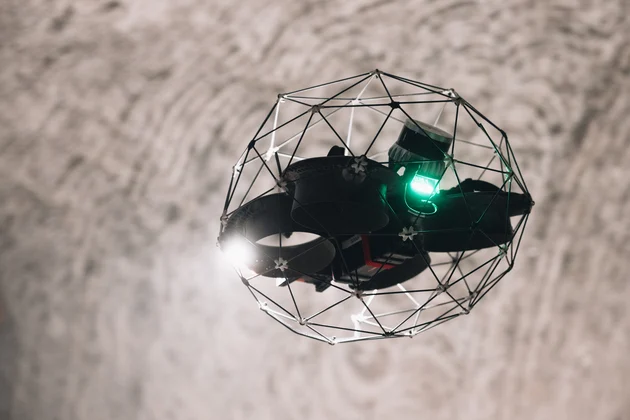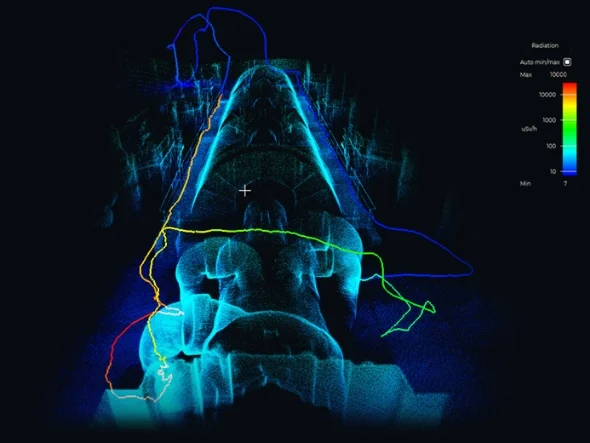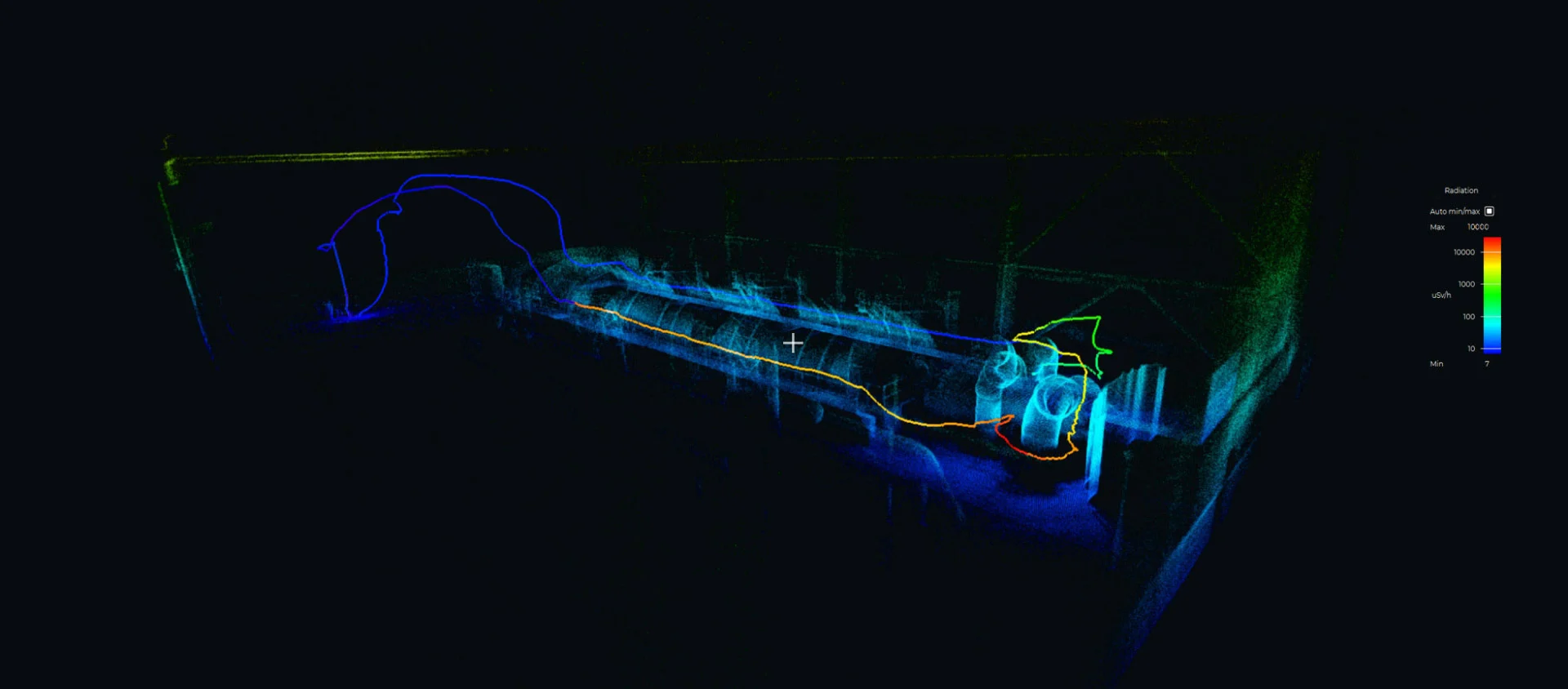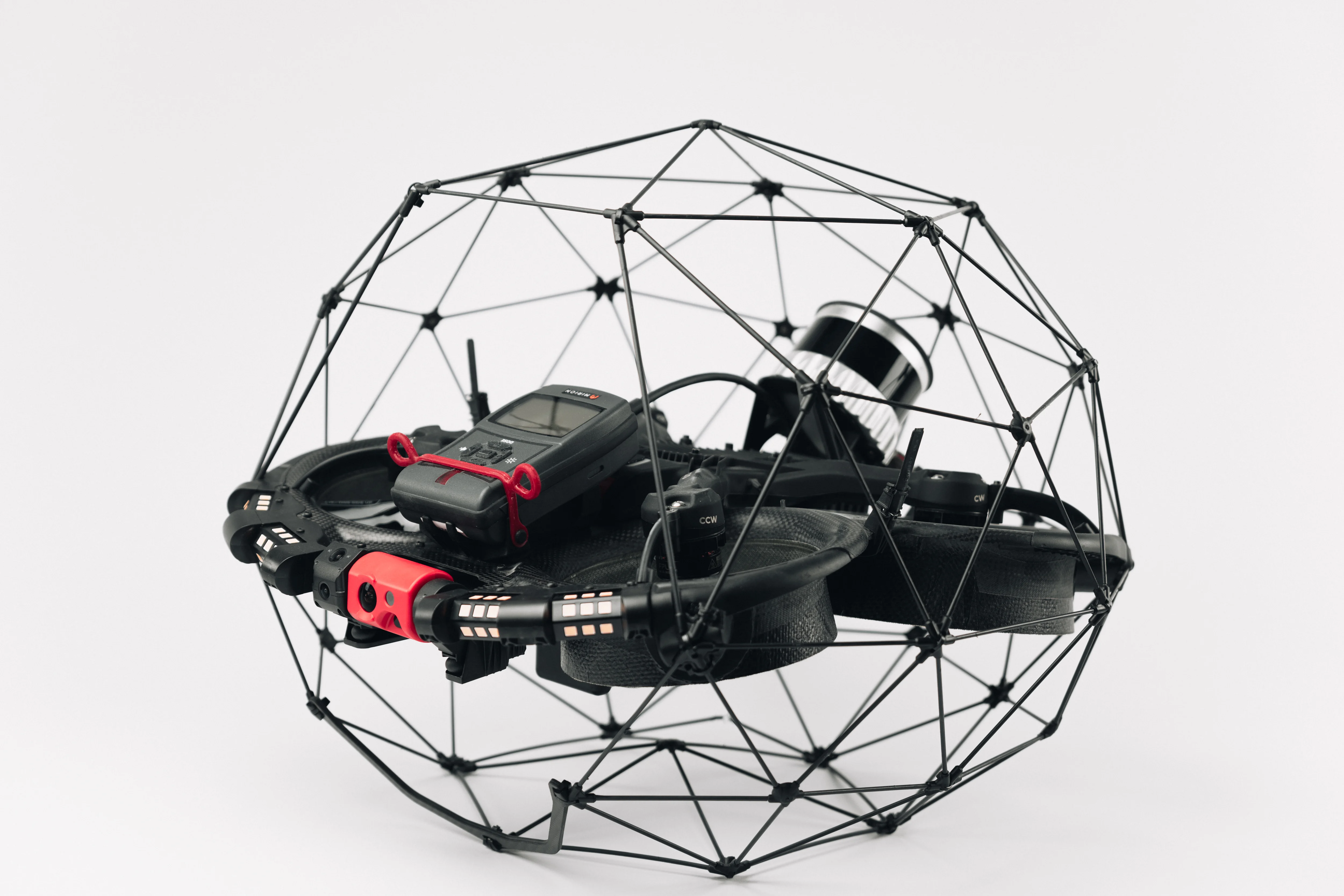Key Benefits at a Glance
|
Access
The Elios 3 RAD allows operators to detect radiation and generate heat maps of contaminated areas without requiring personnel to enter hazardous environments, significantly reducing risk.
|
Comprehensive Data
With the RAD payload, drone pilots can collect detailed information to create accurate radiation heat maps across various confined spaces, ensuring thorough environmental assessments.
|
Â
|
Site Management
The Elios 3 RAD functions as both a scout and inspector, providing critical insights that support efficient site management and informed operational planning.
|
Safety
This system enhances safety by enabling remote data collection through the RAD payload, minimizing human exposure to potentially dangerous areas.
|
What is the Elios 3 RAD?
The Elios 3 RAD is a combination of our modular Elios 3 drone and a specialized radiation detection sensor, designed for efficient and safe radiation inspection workflows.
Launched in 2022, the Elios 3 is engineered for confined space inspections, whether it's navigating the inside of a pipe or exploring unknown areas in caves. Its robust design includes a protective cage and collision-resistant flight algorithms, allowing it to operate confidently in challenging environments. This impact tolerance is achieved through an innovative structure that protects the propellers with a cage, while advanced flight controls stabilize the drone during collisions. These features make the Elios 3 ideal for operations beyond line of sight or in enclosed spaces too dangerous for human entry.

The Elios 3 RAD is a powerful tool for enhancing safety and accelerating operations related to radiation detection.
In 2023, the Elios 3’s modular payload lineup was expanded to include the RAD sensor—short for radiation detection. Developed by Mirion Technologies, a leader in radiological tools, this sensor is expertly designed to detect and measure radioactive materials.
The Elios 3 RAD can identify and measure radioactive substances, ranging from materials found in nuclear power plants to old contaminated assets involved in decommissioning projects.
Using drones for nuclear inspections offers several advantages:
- Enhanced Safety
- Drones can explore hazardous areas ahead of time, assessing radiation levels to determine if it's safe for humans to enter or if additional precautions are needed. This pre-survey supports better planning.
- The drone can alert teams to changes in radiation levels, enabling quick decision-making and response times based on real-time data.
- Improved Data Collection
- The Elios 3 RAD can inspect contaminated zones and gather data that reveals radiation levels, offering insights previously unavailable with traditional remote sensors.
- It collects visual, volumetric, and radiological data, which can be used to build 3D models and conduct radiological surveys efficiently.
- Better Access
- Drones like the Elios 3 RAD allow engineers to access areas they couldn’t before. Whether it’s high up or inside confined spaces, the drone can capture comprehensive data from hard-to-reach locations.
- The Elios 3 can move into areas without human presence, making it ideal for inspecting the interiors of pipes or other structures, provided there's enough space (as small as 50x50 cm to enter and 60x60 cm to inspect).
The sensor used in the Elios 3 RAD is the RDS32-WR, developed by Mirion Technologies. With global expertise in radiological surveys and radiation detection, Mirion is a trusted partner for the Elios 3’s inspection missions.
How Can You Use the Elios 3 RAD for Radioactive Material Operations?
The Elios 3 RAD has a wide range of applications, from inspecting nuclear power plants to supporting nuclear decommissioning efforts. Here are three key examples of its use:
Radioactive Waste Warehouse Management
Managing nuclear waste is a complex task due to the long-term radioactivity of stored materials. In some cases, the Elios 3 has created 3D models of radioactive environments without sending people in. In other situations, waste is stored in sealed barrels lined with cement and kept in monitored storage facilities.
A drone inspection using the Elios 3 RAD in such environments is highly effective. The drone can regularly fly inside the warehouse to monitor radiation levels, following the "ALARA" principle—keeping radiation exposure as low as reasonably achievable.

Here, a turbine deck was scanned with the Elios 3 RAD, showing the drone’s ability to navigate around the entire asset with ease.
By building a database of inspection readings, the Elios 3 RAD helps track changes in radiation levels over time, aiding maintenance planning and rapid response if issues arise. This approach reduces human exposure and improves overall safety.
Site Scans for Radioactive Contamination, Including Powerplants
A simple drone inspection of a nuclear power plant can save up to $500,000. Safety is crucial in these environments, which may contain radioactive materials. With the Elios 3 RAD, pre-scans can be conducted before human entry to assess radiation levels and perform visual checks.
For instance, if a pipe carrying radioactive waste shows signs of damage, the Elios 3 RAD can quickly assess the area, creating a radiation heat map to locate the breach and measure the level of contamination. If exposed to radiation, the drone can remain in place until batteries need replacing and data collected, minimizing the risk of spreading contamination.
This closed-loop operation ensures situational awareness while maintaining strict safety protocols. Case studies like this could occur at nuclear power plants or decommissioning sites, showcasing how the Elios 3 RAD enhances safety and site awareness by gathering data from hard-to-reach places.
Underground Radioactive Material Storage
Another example of radioactive waste management involves underground storage for direct disposal of nuclear waste. Projects like these aim to reduce human contact with radioactive materials by burying them deep in repositories. Some of these spaces are completely sealed, while others require regular monitoring, such as at a U.S. Department of Energy site.

This scan of a turbine deck using the Elios 3 RAD highlights distinct changes in radiation levels across the area.
The Elios 3 RAD can enter these tight spaces to perform visual inspections and radiation surveys, helping teams plan maintenance and reduce on-site time with a pre-prepared strategy based on 3D models. It also ensures continuous monitoring of radiation levels to confirm the stability of stored waste and detect any potential leaks.
Radioactive waste can include items like nuclear powerplant equipment, heavy water, spent fuel rods, or even radioactive concrete. Managing these materials becomes more manageable with the Elios 3 RAD, offering safer and more efficient solutions.
The Future of Drone Inspections in Nuclear Environments
The integration of drones for radiation management marks a significant advancement in improving safety within a growing and complex industry. The Elios 3 drone with the RAD payload can be applied to both nuclear power plants and waste management, where radioactive materials remain hazardous for thousands of years.

As many European countries move toward phasing out their nuclear energy plants, including Switzerland and Germany, the challenge of managing leftover waste and materials will grow. At the same time, the need to inspect existing nuclear power plants remains critical.
As technology continues to evolve, the Elios 3 RAD offers a new way to access previously unreachable areas while improving safety. It represents a promising step forward in the power generation and waste management sectors.
Discover more about the Elios 3 RAD
Precise Casting Parts
Precise Casting Parts,Precise Casting Parts Assembly,Precise Casting Parts And Accessories,Precise Casting Parts Aluminum
Jiangsu Kinuo Furnace Roller Co., Ltd. , https://www.jskinuoroller.com



